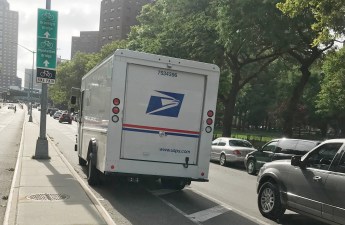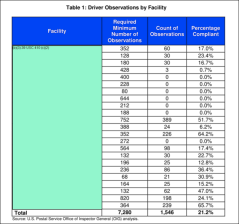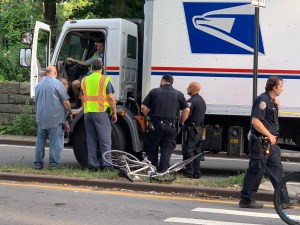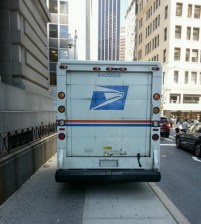Grieving Brooklyn Family Rails at Postal Service ‘Killers’
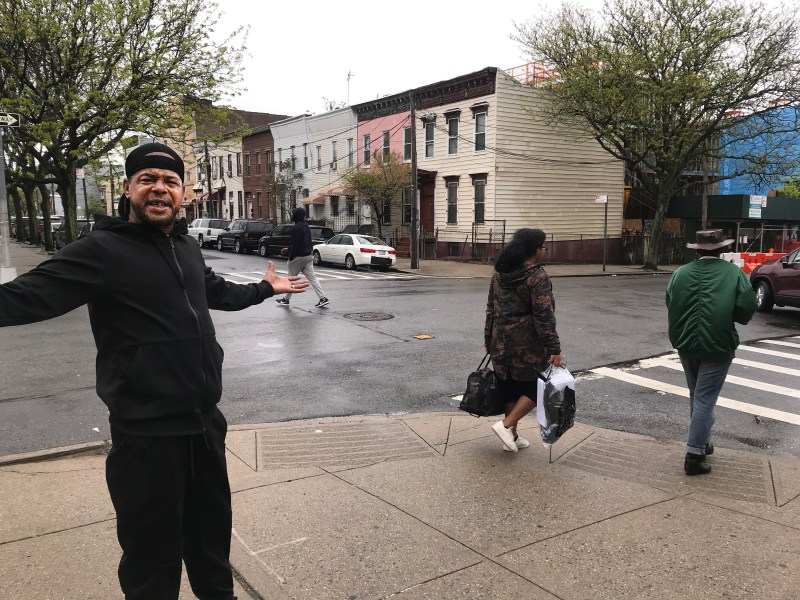
“It’s homicide, as far as I’m concerned.”
That was Gregory McClean, standing in the rain on Sunday, telling Streetsblog about the Friday night death of his younger brother, Charles, who was run down by the driver of a United States Postal Service truck at the corner of Macdougal Street and Howard Avenue in the Ocean Hill section of Brooklyn.

McClean, 52, had gone out for lottery tickets one block from his Fulton Street apartment and never came back. The driver had stopped at the intersection, but then inched further into the roadway, looking only to his left at the oncoming cars — a common practice of drivers at one-way intersections without a traffic light. By the time the roadway was clear for the mail truck driver, McClean was crossing in front. He was knocked down and fatally dragged through the intersection.
“There was no way he could be saved,” Gregory McClean, the oldest of the eight McClean brothers, said at the intersection as he watched car after car make the same mistake that the mail truck driver made. “It’s wrong. We’re not safe crossing our own crosswalk. They’re looking only for the cars, not at the people crossing.

“But this is a federal worker!” McClean continued, pointing to the postal service station halfway up the block — where the driver was heading at the time of the 5:06 p.m. crash. “They drive so fast in this neighborhood, just rushing to clock out. This driver was a young guy. Well, you hired him! Train him! It’s recklessness. I call it homicide!”
The dead man’s other brother, Arkim, said he had long ago noticed that United States Postal Service trucks do not have license plates — and therefore are not ticketed by the NYPD for all manner of violations to which all other drivers are subject.
“No license plates means no tickets and no accountability,” Arkim McClean said. “If I have to have a license plate and I can get a ticket, they should have the same thing.”
The NYPD declined to identify the mail truck driver, who remained on the scene. Cops said no charges had been filed against him.
Police also could not immediately say how many USPS trucks have been involved in crashes this year. The lack of license plates on United States Postal Service vehicles makes driving records of postal workers nearly impossible to track.
A traffic enforcement officer told Streetsblog that his commanding officer told him not to bother even writing tickets when he sees USPS trucks parked in bike lanes, parked illegally, blocking crosswalks or doing other dangerous things that New Yorkers see every day.
“They drive terribly,” the enforcement officer said. “I want to give them tickets, but they don’t have to pay them so my C.O. said it’s a waste of my time. He’s right, but it makes me feel like I’m not doing my job.”
The Postal Service has not commented publicly since Friday’s crash. The USPS website offers no way to check safety records, and the inspector general has rarely examined the mail service’s record. Last year, in a blog post, the IG’s office said it had spot-checked the safety record of the Great Lakes region — which had the highest accident frequency rate,, 17.9 crashes per 100 employees, of all seven Postal Service areas in the two prior years.
“Great Lakes management did not consistently adhere to safety compliance and accident reporting requirements,” the report said.
The Postal Service has not released any analysis of safety since an audit in 2012 found that none of the managers at 23 postal service regions “completed the required minimum [safety] observations” of drivers. Seven regions did not do any safety observations at all, though it is impossible to know which regions had the worst records because the audit is redacted.

In the two years prior, postal service drivers got into 40,000 motor vehicle crashes, averaging out to 9.2 accidents per million miles driven, the audit said.
One postal worker posted a comment on the Inspector General’s Great Lakes report that was very telling:
Carriers, the commenter posted, “are constantly pushed to work faster and harder no matter what it takes to deliver and get back: exceeding speed limits in certain areas, multiple back-tracking, u-turns, three-point turns, backing up, etc.”
“Management tells you to just do it, but they will deny they said it and will not back you if there is an accident,” the worker said. “Pressured to just hit the street and deliver and get back quickly.”
